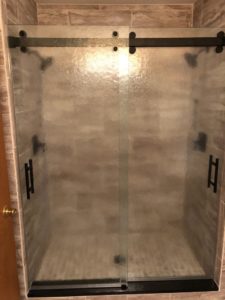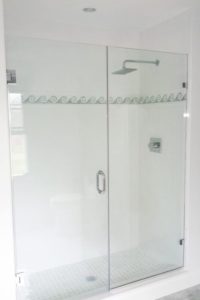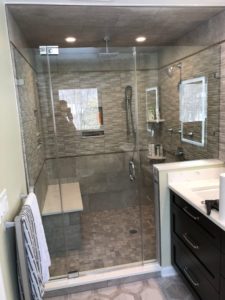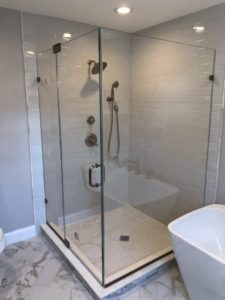 Types of Shower Enclosure Systems We Provide Installation for in New Jersey
Types of Shower Enclosure Systems We Provide Installation for in New Jersey
A shower enclosure puts the finishing touch on your bathroom. It’s both aesthetic and functional — in other words, it needs to look beautiful and keep the water from the shower where it belongs. Whether you have a compact condo bathroom or a full bath, understanding the different shower enclosure types can help you make the right choice.
Framed Shower Door Installation
Framed shower doors are one of the most common types of enclosures. These glass doors feature metal frames; the frames might extend around the outer edge or across the center of the panel. Although this type of door usually uses thinner glass, the frames add extra stability and structure. When it comes to visuals, the metal frames make a bold visual statement — particularly in a small bathroom. This type of door can usually be adjusted to fit your shower size and bathroom.
Frameless Shower Doors
Frameless shower doors are doors made without metal frames. Since the doors don’t rely on metal supports for structure, they’re usually made from heavy, thick glass that’s strong enough to hold its shape. The individual components are easy to find, which makes for hassle-free shower door repair. Since these doors don’t use metal frames, they’re measured and cut precisely to ensure the right fit for the shower door installation.
 Semi-Frameless Shower Doors
Semi-Frameless Shower Doors
Semi-frameless doors are midway between framed and frameless — in other words, they have some metal components, but not a full frame. This results in a lighter, more transparent look that still offers a hint of metallic shine. Semi-frameless models use glass that’s slightly thicker than the glass used in framed doors, so they often feel sturdy and solid. The metal components allow easy adjustments.
Bi-Fold Shower Doors
A bi-fold shower door features two tall, narrow panels of glass. These doors usually have two sets of hinges: one that connects the edge of the door to the shower, and another that connects the two panels. The free corners of the door slide along top and bottom tracks, keeping them in place. Instead of swinging in or out like a standard shower door, the two panels fold together and lie flat against the inside of the shower. This saves space in small bathrooms.
Curved Shower Doors
Curved shower doors extend from one wall, curve outward, and finish at an adjacent wall. They’re usually used on compact corner showers, although you can also find larger versions. Because of the curve, these doors take up less space than square doors, making them an ideal choice for small bathrooms. The door may swing or slide open. The rounded edge creates a sleek, organic look that suits a modern bathroom. You can choose from both framed and frameless models.
 Sliding Shower Doors
Sliding Shower Doors
Sliding shower doors open and close using top and bottom tracks. The glass panels slide along rollers, allowing you to move them without damaging the edges. Usually, these doors feature a long bar or an individual handle for easy opening. Sliding doors are ideal for bathrooms with a limited amount of space in front of the shower; since they don’t swing in or out, they don’t take up extra room. You can select sliding doors with or without metal frames to create a custom look.
Fixed Shower Doors
Fixed shower doors are glass panels that don’t open or close. Essentially, they’re glass walls that block the shower spray. These fixed doors are paired with an open area so you can walk in or out. Because they have fewer components and less glass, these types of doors are often easy to clean and maintain. They also maintain the lines of sight in your bathroom, creating an open and airy look.
Hinged Shower Doors
Hinged shower doors use metal hinges to allow the door to swing open and closed. The hinges can usually be placed on either side of the door, depending on your bathroom layout. In larger showers, you might opt for doors that open inward; this prevents water on the door from dripping on your floor. Other models open out to allow you more room to maneuver inside the shower.\
 Folding Shower Doors
Folding Shower Doors
Folding shower doors feature two or more panels. The panels are connected by hinges, allowing them to fold together like an accordion. When you open the doors, they fold against the shower wall to create an opening. In many cases, these doors are used to save space. The edges of the door panels stay inside the shower, so the water drips into the shower pan or bathtub. If part of a folding door is damaged, you may not need a full shower door replacement; instead you may be able to save by replacing a single panel.
The Style of Glass We Offer for Shower Enclosure Systems
After you choose a shower door style, it’s time to choose a glass style.
Clear Glass
Clear glass is completely transparent. It allows you to see through the enclosure, creating a more open environment. This glass is a great way to show off an attractive shower design or beautiful tile work.
Frosted
Frosted glass is textured on one or both sides, usually using acid or sand. The small indentations in the glass scatter the light and prevent the glass from being completely see-through.
Patterned
This type of glass features raised or depressed patterns on the surface. The patterns are often decorative, and add a bit of visual interest to your bathroom.
Obscure
This type of glass obscures visibility between your bathroom and the interior of the shower, creating extra privacy. You can choose painted glass, tinted glass, or glass that has a pattern or texture embedded in the panel itself.
Rain
Rain glass is a type of textured glass that looks like rain droplets or swirling eddies of water. It distorts visibility and increases privacy.
Katarina’s Glass & Shower Doors provides top-of-the-line installation, repair, and replacement for all shower door enclosure types. If you live in New Jersey, our fast, professional service helps you return your bathroom to full functionality.

 Types of Shower Enclosure Systems We Provide Installation for in New Jersey
Types of Shower Enclosure Systems We Provide Installation for in New Jersey Semi-Frameless Shower Doors
Semi-Frameless Shower Doors Sliding Shower Doors
Sliding Shower Doors Folding Shower Doors
Folding Shower Doors